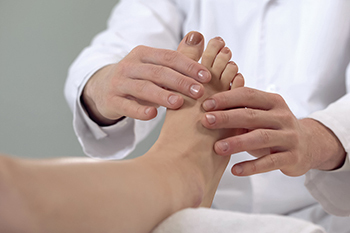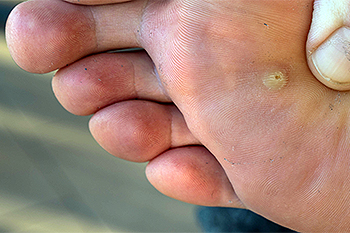

A bunion is a bony bump that can develop on the side of the big toe. If a patient does not respond to more conservative treatments to correct this deformity, then a surgical procedure might be recommended in some cases. Following the surgical procedure, your podiatrist may advise that some kind of physical therapy is performed. Cryotherapy, or cold therapy, might be recommended where the intention is to decrease swelling in the affected area. Potential physical therapy options might also include some kind of gait training, where a physical therapist helps you walk normally or correct any limping tendencies. Lastly, proprioceptive balance training might be another form of physical therapy that is meant to improve and increase stability. If you have bunions and want to learn more about physical therapy following a surgical procedure, contact a podiatrist today.
Foot surgery is sometimes necessary to treat a foot ailment. To learn more, contact Dr. Todd Goldberg of Complete Family Foot Care Center. Our doctor will assist you with all of your foot and ankle needs.
When Is Surgery Necessary?
Foot and ankle surgery is generally reserved for cases in which less invasive, conservative procedures have failed to alleviate the problem. Some of the cases in which surgery may be necessary include:
What Types of Surgery Are There?
The type of surgery you receive will depend on the nature of the problem you have. Some of the possible surgeries include:
Benefits of Surgery
Although surgery is usually a last resort, it can provide more complete pain relief compared to non-surgical methods and may allow you to finally resume full activity.
Surgical techniques have also become increasingly sophisticated. Techniques like endoscopic surgery allow for smaller incisions and faster recovery times.
If you have any questions please feel free to contact our office located in Littlestown, PA . We offer the newest diagnostic and treatment technologies for all your foot and ankle needs.

If you notice that your toenails have become thickened, rough, or stained it may be a sign of onychomycosis, also known as toenail fungus. This fungal infection is contagious and quite common among older adults. Touching the infected nail or any surface infected with the fungus can allow it to spread. The fungus thrives in moist, warm environments like gym locker rooms, swimming pools, and changing areas. If your feet or shoes are damp or sweaty, the fungus is more likely to multiply and feed on the nail tissue. Eventually, it may grow under the nail into the skin, turning the nail yellow and changing its appearance. Toenail fungus is not generally painful, but the nail may develop cracks. Protection against infection includes keeping the feet clean and dry, sprinkling antifungal powder inside shoes, and wearing shoes made of breathable materials. It is suggested that you wear foot coverings when you are in damp areas where the fungus is apt to spread. Please see a podiatrist for more information on medications to combat fungal toenail infections.
If left untreated, toenail fungus may spread to other toenails, skin, or even fingernails. If you suspect you have toenail fungus it is important to seek treatment right away. For more information about treatment, contact Dr. Todd Goldberg of Complete Family Foot Care Center. Our doctor can provide the care you need to keep you pain-free and on your feet.
Symptoms
Treatment
If self-care strategies and over-the-counter medications does not help your fungus, your podiatrist may give you a prescription drug instead. Even if you find relief from your toenail fungus symptoms, you may experience a repeat infection in the future.
Prevention
In order to prevent getting toenail fungus in the future, you should always make sure to wash your feet with soap and water. After washing, it is important to dry your feet thoroughly especially in between the toes. When trimming your toenails, be sure to trim straight across instead of in a rounded shape. It is crucial not to cover up discolored nails with nail polish because that will prevent your nail from being able to “breathe”.
In some cases, surgical procedure may be needed to remove the toenail fungus. Consult with your podiatrist about the best treatment options for your case of toenail fungus.
If you have any questions, please feel free to contact our office located in Littlestown, PA . We offer the newest diagnostic and treatment technologies for all your foot care needs.

Flat feet, medically known as pes planus, occur when the long arch of the foot has not developed properly. Children are born with flat feet, but usually develop healthy arches by the age of five. Some people are genetically inclined to have flat feet. Others develop them as a result of a condition, such as diabetes, a stroke, or rheumatoid arthritis. Weight gain and standing for long periods of time can cause discomfort if you have flat feet, but most people do not experience pain from this condition. Wearing shoes with good arch support and cushioning in the heel can be a plus, if you have flat feet. A number of stretching and strengthening exercises can help to relieve any heel pain caused by flat feet. If being on your feet is a requirement of your job or lifestyle, wearing orthotics may be a good option. A podiatrist can assess the extent of the condition and prescribe custom shoe inserts to address it. For more information about flat feet and how they can be treated, it is a good idea to make an appointment with a podiatrist.
Flatfoot is a condition many people suffer from. If you have flat feet, contact Dr. Todd Goldberg from Complete Family Foot Care Center. Our doctor will treat your foot and ankle needs.
What Are Flat Feet?
Flatfoot is a condition in which the arch of the foot is depressed and the sole of the foot is almost completely in contact with the ground. About 20-30% of the population generally has flat feet because their arches never formed during growth.
Conditions & Problems:
Having flat feet makes it difficult to run or walk because of the stress placed on the ankles.
Alignment – The general alignment of your legs can be disrupted, because the ankles move inward which can cause major discomfort.
Knees – If you have complications with your knees, flat feet can be a contributor to arthritis in that area.
Symptoms
Treatment
If you are experiencing pain and stress on the foot you may weaken the posterior tibial tendon, which runs around the inside of the ankle.
If you have any questions please feel free to contact our office located in Littlestown, PA . We offer the newest diagnostic and treatment technologies for all your foot and ankle needs.

Plantar warts are found on the bottom of the feet, and can be very painful. The majority of warts grow outward, but plantar warts grow inward as a result of standing and walking for most of the day. The medical name for this type of wart is a verruca, and is connected with the human papillomavirus (HPV). The wart appears as a small, thickened area of skin on the bottom of the foot, and many times will have tiny black dots in the center. The virus can enter the body through small cracks in the skin of the feet, and generally lives in warm and moist environments. These can include public swimming pools, shower room floors, and locker rooms. It is advised that appropriate shoes, like flip flops or water shoes, are worn while in these areas. Plantar warts can be extremely uncomfortable, and many patients seek immediate relief. If you are afflicted with a plantar wart, please consult with a podiatrist who can discuss several effective treatment options with you.
Plantar warts can be very uncomfortable. If you need your feet checked, contact Dr. Todd Goldberg from Complete Family Foot Care Center. Our doctor will assist you with all of your foot and ankle needs.
About Plantar Warts
Plantar warts are the result of HPV, or human papillomavirus, getting into open wounds on the feet. They are mostly found on the heels or balls of the feet.
While plantar warts are generally harmless, those experiencing excessive pain or those suffering from diabetes or a compromised immune system require immediate medical care. Plantar warts are easily diagnosed, usually through scraping off a bit of rough skin or by getting a biopsy.
Symptoms
Treatment
To help prevent developing plantar warts, avoid walking barefoot over abrasive surfaces that can cause cuts or wounds for HPV to get into. Avoiding direct contact with other warts, as well as not picking or rubbing existing warts, can help prevent the further spread of plantar warts. However, if you think you have developed plantar warts, speak to your podiatrist. He or she can diagnose the warts on your feet and recommend the appropriate treatment options.
If you have any questions please feel free to contact our office located in Littlestown, PA . We offer the newest diagnostic and treatment technologies for all your foot and ankle needs.